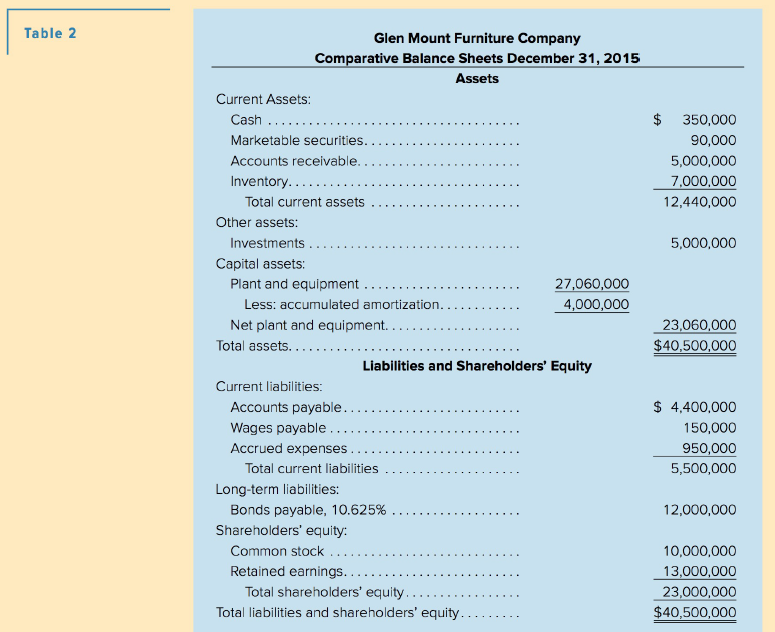a. Project EPS for 2016 assuming that sales increase by $500,000. Use Table 3 as the model
Question:
b. By what percent did EPS increase from 2015 to 2016?
c. Now assume $10 million of debt replaces 625,000 shares of common stock as described in the case. The interest on the new debt will be 11.250 percent. What will projected EPS be for 2016 based on the anticipated sales increase of $500,000?
d. Based on your answer to part c, by what percent would EPS increase from 2015 to 2016?
e. Compute the degree of financial leverage (DFL) for the answers to part a and part c.
f. Compute degree of combined leverage (DCL) for the answer to part a and the answer to part c.
g. What is the total-debt-to-total-assets ratio as shown in the 2015 balance sheet (Table 2)? What will it be if $10 million worth of shareholders' equity is replaced with debt?
h. What do you think might happen to the share price as a result of replacing $10 million worth of shareholders' equity with debt? Consider any relevant factors.
GLEN MOUNT FURNITURE
Furniture magnate Carl Thompson couldn't believe the amount of pressure security analysts could put on a firm. The Glen Mount Furniture Company was a leading manufacturer of fine home furnishings and distributed its products directly to department stores, independent home furnishing retailers, and a few regional furniture chains. The firm specialized in bedroom, dining room, and living room furniture and had three plants in Quebec and two in Ontario. Its home office was in Granby, Quebec. In a recent presentation to the Montreal chapter of the Financial Analysts Federation, Carl Thompson barely had taken a bite out of his salad when two analysts from a stock brokerage firm began asking questions. They were particularly concerned about Glen Mount's growth rate in EPS.
Carl was aware that security analysts considered earnings performance to be important, but he was somewhat distressed by the fact that this seemed to be their overriding concern. It bothered him that the firm had just spent over $10 million to develop exciting new product lines, modernize production facilities, and expand distribution capabilities, and yet all the questions seemed to deal with near-term earnings performance. He believed he would eventually have an opportunity to discuss the above-mentioned management initiatives and their impact on the company for the next decade, but current EPS seemed to gather the attention of the analysts.
Carl knew only too well from past experience that the earnings performance of the firm would affect the company's price-earnings ratio and its market value. Furthermore, before Carl became president of Glen Mount Furniture Company, he had attended a six-week executive development program at the Western Business School in which he heard a number of professors stress the importance of the goal of shareholder wealth maximization. He often wondered if other items were not equally important to the company, such as community service. (The firm donated $60,000 a year to a local university to help supplement faculty salaries for outstanding professors.) He also had a sense of pride that his firm provided employment to over 500 people in the area. He was not sure that the security analysts would consider these items important. With all of these thoughts in mind, his upcoming meeting with Chief Financial Officer Barbara Baines worth became particularly important. When Barbara arrived, she had a number of financial documents to review before making key decisions. In Table 1 she showed the earnings performance of the company over the past five years. Table 2 provided a current balance sheet, and Table 3 represented an abbreviated income statement for 2015.
The firm was considering buying back 625,000 shares of stock outstanding at $16 per share. This would represent $10 million in total. The funds to purchase the shares would be acquired from a new bond issue that would carry an interest rate of 11.25 percent. The bond would have a 15-year life. The firm was in a 34 percent tax bracket.


Table 3
Glen Mount Furniture Company
Abbreviated Income Statement
For the Year ending Dec. 31,2015
Sales....................................................$45,000,000
Less: Variable costs...............................26,100,000
Fixed costs . . . . . . ........ . .. .. .. . ...... ...12,900,000
Operating profit (EBIT).............................6,000,000
Interest ....... . ... . .......... . .. . . .. . ...........1,275,000
Earnings before taxes (EBT)....................4,725,000
Taxes@ 34% ...... . . . ........ .....................1,606,500
Ea rnings after taxes..............................$ 3,118,500
Common Shares outstanding .... .. .. . ... .2,000,000
EPS ......................... ... .. . .. .... .....................$1.56
Capital structure refers to a company’s outstanding debt and equity. The capital structure is the particular combination of debt and equity used by a finance its overall operations and growth. Capital structure maximizes the market value of a... Distribution
The word "distribution" has several meanings in the financial world, most of them pertaining to the payment of assets from a fund, account, or individual security to an investor or beneficiary. Retirement account distributions are among the most...
Step by Step Answer:

Foundations of Financial Management
ISBN: 978-1259024979
10th Canadian edition
Authors: Stanley Block, Geoffrey Hirt, Bartley Danielsen, Doug Short, Michael Perretta





